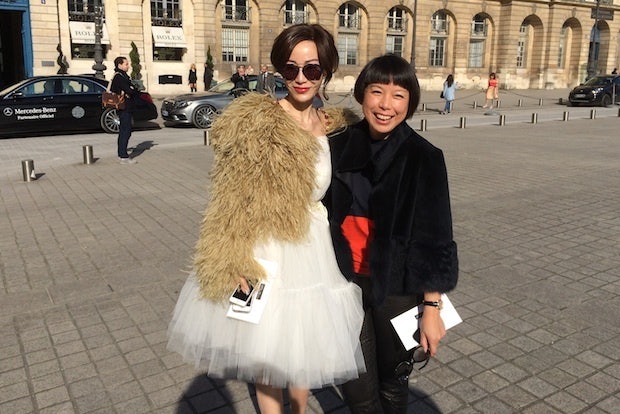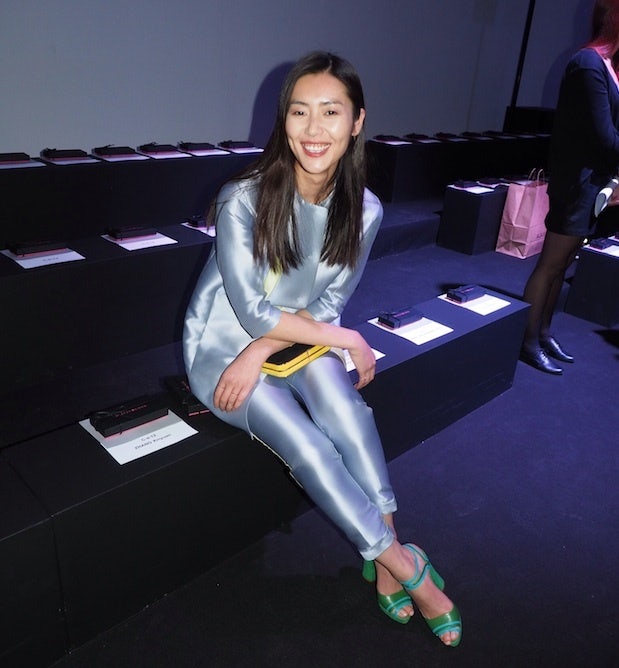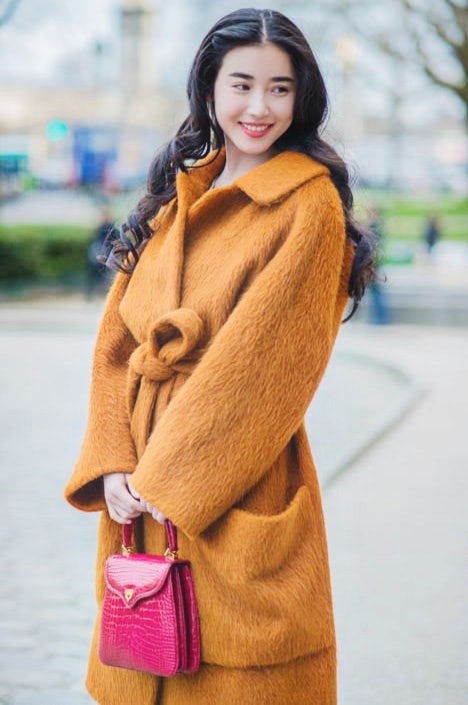
Vogue China Editor Angelica Cheung (R) and Shanghai writer Ya Qi (L) at Paris Fashion Week. (Brandie Raasch)
For one week every spring and fall, Paris Fashion Week becomes a global style epicenter, attracting editors, buyers, fashionistas, stars, and press from all over the world. This, of course, includes China—and once again this season, there was no shortage of top Chinese celebrities, opinion leaders, designers, and models.
In order to get the scoop on all the Paris Fashion Week on-the-ground happenings, we checked in with Susan Owens, the founder and editor of Paris Chérie, a Paris-based fashion blog dedicated to bringing French style news to Chinese readers. Since Owens was attending shows and witnessing the street style action all week, we caught up with her to hear about her favorite Chinese designers and the strength of China’s presence this season, as well as what inspired her to start a French blog for Chinese readers.
Who have been the standout Chinese designers at Paris Fashion Week this season?#
Masha Ma for taking a new challenge and a bold new direction. She called it her quest for “lightness”. Shiatzy Chen for her exhilarating use of color, and Yang Li for his elegant new volumes.
London had a strong showing of Chinese designers, and Uma Wang chose to do her first runway show in Milan, but ultimately, Paris remains the epicenter.
In recent years, Paris Fashion Week has always seen an influx of Chinese celebrities, models, and press. Do you think their presence was as strong as in recent seasons?#
Chinese fashion press members were definitely present, and gave strong coverage to Chinese designers this season. For example, Krystal Gao, fashion editor of China’s iLook, wrote, “The Chinese designers showing in Paris are pushing themselves further and looking to their own culture for a point of difference. It’s their unique point of view which is their strength.”
Meanwhile, Amy Liang, an international buyer for Chic St in Shanghai said, “Young Chinese women are driving the focus on homegrown designers, which gives them international attention in Paris. Young women do like to invest in an Hermès or Chanel bag, less so a Louis Vuitton bag. Then, they want to be playful and wear clothes by new, lesser-known designers. They increasingly support Chinese designers.”
Chinese models have stealth power in Paris. Mega-star Liu Wen walked in Nina Ricci, Givenchy, and Chanel, and then sat as a front row guest at Shiatzy Chen. It’s no surprise that she’s so adored by the media. Even off-duty, she will stop for a photo.
For a few examples of Chinese models at major shows, Shu Pei Qin, Fei Fei Sun, and Xiao Wen Ju walked in the most coveted show—Chanel. Meanwhile, we also saw Xiao Wen Ju walk in Lanvin and Chloé. We saw Ming Xi at Guy Laroche. Fei Fei Sun is a shining star, who also walked in Lanvin and Givenchy.

Supermodel Liu Wen front-row at Shiatzy Chen. (Benedicte Bro)
Which front-row Chinese celebrities were at the runway shows this season?#
The front row was stronger during the January couture shows, in terms of Chinese celebrities. That said, there were still many—one of the most prominent was Fan Bing Bing at Louis Vuitton. Multimedia artist Yi Zhou was front row at Chanel, Givenchy, and Lanvin. We actually had the chance to talk to her after Chanel, and she said, “Chanel’s supermarket runway was inspired. Taking cultural references as backdrop for art, that’s my kind of thing.”
At Shiatzy Chen we spotted celebrity media couple Li Xiang and husband Wang Yuelun, as well as “it” girl Zhang Xinyuan. Model and television presenter Bonnie Chen was front row at Chloé and at Céline, designer Phoebe Philo greeted the actress Faye Wong, and Yu Wenxia, China’s first Miss World (2012), was at the last show.
Have you seen any trends this season that appear to be aimed specifically at the China market?#
An abundance of primary colors—for a season that is traditionally dominated by the European preference for black—in winter. Embellishments—from shards of tinkling gemstones on shoes and handbags and gloves—to luxurious fabrics, and particularly embroidery.

Krystal Gao, fashion editor of Chinese magazine iLook, at Chanel's supermarket-themed runway show during Paris Fashion Week. (Brandie Raasch)
Which labels’ new collections have been favorites in China?#
Paris labels that got the big votes included Dior for the strong color palette, as well as Givenchy, where designer Riccardo Tisci abandoned “tough-gal chic” for a softer side with tea dresses and prints.
All eyes were on Louis Vuitton, which has had softer sales in China. The new designer, Nicholas Ghesquiere, who replaced Marc Jacobs, showed a triumphant edition of luxury sportswear that must bode well for China.

Zhang Xinyuan at Shiatzy Chen. (Brandie Raasch)
Can you give us an overview of the concept of#
Paris#
Chérie#
?#
Paris Chérie connects affluent Chinese women to the world’s most fashionable city, sending daily news in Chinese (simplified) and English for our Chinese followers around the world. Our writers are “front rowers” and increasingly Chinese journalists living in Paris.
What inspired you to start the site?#
I was born in Australia, where we understand the “tyranny of distance”. As a teenager I subscribed to French Elle, longing for it to drop in the postbox. As a journalist in Paris, writing with a focus on “the business of luxury” and the “French-China dynamic”, I had a simple idea: “Let’s send daily news from Paris to the world’s fastest-growing and youngest fashion market—we can have a team here when even the major fashion magazines in China do not.” I was overjoyed when I got that publishing license for China and we jumped the firewall.
Your site is bilingual, in English and Chinese. Is the content different on each site? Is there any type of content that Chinese readers prefer more than English readers?#
The content is precisely the same on each site. We increasingly work with Chinese writers in Paris who are taking a “Chinese point of view”. Our English-language readers are mostly Chinese living in the United States, Hong Kong, and Europe.
Your target audience includes Chinese women aged 18-34. How important is this demographic for fashion labels now, and how important will it be in the next five years?#
That demographic is the strongest issue for European luxury in 2014. Sales of womenswear in China have a projected growth rate of 8-10 percent in the 12 months ahead. That stems from the rapid-fire sophistication of the Chinese consumer—and the female spend absorbing the slowdown in sales to men—reflecting the crackdown on the culture of “gifting”.
In the next five years, as sophisticated women make spending choices, they will remain the “apple of the marketing man’s eye”. A dramatic change is ahead. In 1995, 90 percent of the luxury spend was by men. In 2013, the luxury spend by women equaled that of men.